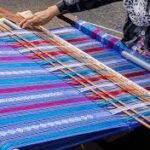In a harmonious blend of heritage and contemporary aesthetics, the celebration of National Handloom Day is on August 7th in India. It brings to the forefront the latest trends in Indian handloom fashion. This annual observance pays homage to the nation’s rich cultural legacy of handloom weaving. These traditional patterns and designs find new life sustainably and artistically statements.

Celebrating the importance of Handlooms
The handloom industry in India, deeply ingrained in the country’s cultural fabric. Handloom has evolved over the years while keeping its authenticity intact.
These intricate designs and classic motifs are passed down through generations.
They are being skillfully reimagined by the country’s diverse artisan community to cater to the evolving tastes of today’s fashion-conscious consumers.
With the delicate elegance of chanderi silk to the intricate artistry of kalamkari embroidery, India’s handloom sector boasts an array of textures, patterns, and fabrics that are revered globally.
The comfort and allure offered by handloom garments are unparalleled. These garments are versatile enough to be worn at parties or during daily tasks, embodying in them both grace and practicality.
The heart of this celebration lies in the handloom saree. A Handloom saree is a quintessential Indian garment that has stood the test of time. The resurgence of handlooms such as Banarasi silk and Chanderi, which are deeply entwined with India’s cultural heritage . It is often wore on festivities have stood the test of time.
The handloom saree, one of the oldest drapes in the world, has transcended generations and geographic boundaries, shaping the current fashion zeitgeist.
Sustainability takes centre stage in the evolution of handloom fashion. Designers and artisans are embracing eco-friendly practices and experimenting with innovative yarns. Bamboo, with its luxurious feel, and hemp, known for its durability, are finding their way into handloom sarees, creating pieces that are not only timeless but also long-lasting heirlooms.
Empowering sections of society
Empowerment is another crucial theme threads of which are evident into the narrative of handloom fashion. Debaroopa Bhattacharya, the founder of Ummaira, acknowledges the vibrancy of Tangail, the artistry of Bishnupur, and the elegance of Murshidabad Silk. These sarees not only signify cultural significance but also embody the spirit of empowered women weavers. Sustainable brands are nurturing a flourishing ecosystem, empowering these unsung heroes who preserve heritage.
Regions like North-eastern India witness increased involvement of women in crafts like Phanek weaving, while CSR projects in Assam. Along providing financial empowerment through basket weaving and mat weaving training.
Conclusion
As National Handloom Day approaches, it’s evident that the tradition of handloom weaving is not just surviving but thriving, adapting to modern sensibilities while remaining deeply rooted in tradition.
The celebration is a testament to the enduring legacy of Indian handloom fashion. The tireless efforts of artisans and designers who keep this heritage alive through sustainable practices and innovative designs.
The Magnificent handlooms serve as a bridge between the past and the future of fashion.






